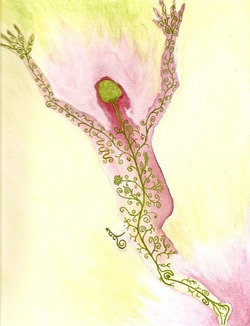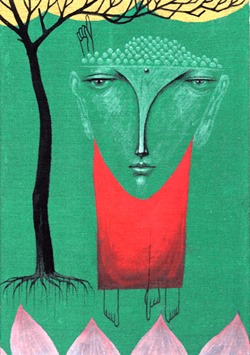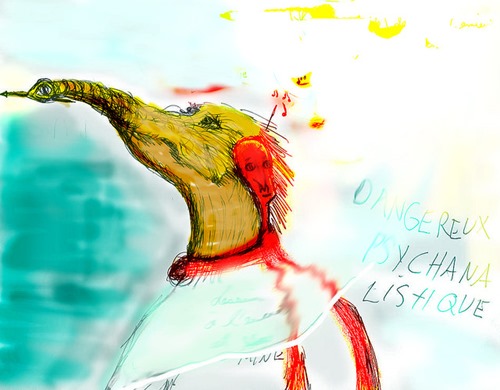The Art of Cultivating Energetic Balance
Many of us have what we often refer to as "energy problem". The energy in our body and mind fluctuates from one week to another, from one day to another, and on the same day, one moment to the next. Most of the time, this is out of our control. Like during a lecture or a meeting when we should have active energy, suddenly all we feel is drowsiness. Before bed we should have passive energy, we feel restless so we twist and turn, and wake up the day after with the face of a torn piece of cloth.
The energy varies from one person to another too. Some are dominated by active energy. Some are dominated by passive energy. That's why certain people seems to know of nothing but slacking. They don't take risk. They don't go the extra miles. They don't care so much about stuff like career planning. They may have a comfortable life, but they lacks of sparks and vitality.
Certain people seem to be always hyper, as if they have an extra pair of AAA battery hidden somewhere below their tailbone. They do things, go places. They work hard, and work harder. And most of them have plans to be an achiever. They may have a eventful life, but they often become agitated, restless, and burn. Their effort becomes counterproductive and it feeds on more frustration.
I've always wondered about the force of energy behind this very human phenomenon. Perhaps you know of Yin and Yang. But how do we make these opposing forces complimentary? How do we turn duality into non-duality? How do we do this to the forces within ourselves? How do we create the harmony so that we are imperturbably balanced and centered and whole, from one moment to the next?
The 5000-year-old yoga tradition is all about holistic health - a large part of that includes the art of cultivating energetic balance. Through reading the yoga text, I learned a useful tool in understanding the patterns of our thoughts, emotions, and actions.
There are 3 difference natural tendencies of the human energy:
-
Rajas: Active, or Yang. It allows us to get out of bed in the morning and move through the day feeling energized. If excessive, it makes us unable to rest, sleep, and find contentment in our lives. The root of rajas is the feeling of needing or losing something, to the point of obsession. That's why it compels us to act because if not, we fear losing what we feel we need. Rajas involves a sense of intense dynamism which leads to passion, excitement, but also restlessness, agitation, and anxiety.
-
Tamas: Passive, or Yin. It allows us to calm down, relax, and restore our energy through rest and sleep. If excessive, it leads to confusion, indecision, inaction. The root of tamas is the feeling of not knowing what we're feeling or what we want or need.
-
Sattva: the 3rd force. This is regarded by both Zen and Yoga tradition as human's natural state of mind. It characterizes clarity, lightness, tranquility, calmness. When one is fueled with sattvic energy, one feels complete and fulfilled. He is then kinder toward himself and others. His emotional state does not depends on external factors, thus he is able to navigate through the world with harmony and ease.
Since the all three lives within each and every one of us, the true art of living is about balancing them. They are neither good, nor bad; each of them is neither better than the other, nor worse. With time, we need to learn how to let one of the forces become dominant at the appropriate circumstances and time. The harmonic coactions of these forces lead to holistic health.
"Without tamas, we would never sleep. Without rajas, we would never move. Without sattva, we would never calmly shine forth in the world."
Mark Stephens
We need to learn how to relax when it's time to rest, how to energize when it's time to show up for our good work.
In the years when I didn't practice yoga, and wasn't aware of this knowledge. I thought of my energy as something I was either born with: "I am just an active hyper restless person. This is who I am. Take it or leave it." Or something given to me by a mysterious hand each morning: "Here it is! This is your energy for today. Live with it." It was like playing the dice. I left my energy up to chances. But now I know this is something we have the power to alter.
I spot the overflow of rajas by the level of agitation and anxiety. And I spot the excess of tamas by the level of hollowness and emptiness. Whenever this happens, almost every day, If I'm mindful enough to acknowledge its happening, I would try to allow myself a moment of "sattvic restoration". Yoga, meditation, and breathing help. A brief walk in nature helps. A moment of aloneness and silence helps. Writing helps.
Recently my freelance work is scheduled in the afternoon; hence I'm prone to anxiety and agitation then. My mind races like a panic horse and I jump from one task to the next, out of breath. I feel drained and I feel like shit. Somewhere along the line I began to hate my job and I began to hate my life. If I'm intelligent enough to listen to my inner guidance - which unfortunately doesn't happen all the time - I will sit down on my meditation cushion and do some rounds of yogic breathings, or roll out my mat and do 10 minutes of relaxation yoga. I always feel significantly better.
We all need this sattvic restoration during our day to remind us of our true nature. Walk back to the center seat of our consciousness. That is the best place to be, to see, to act.
Once you've experienced the exquisite feeling of sattvic energy, you may want to have it forever. In my experience, this takes practice, a lot of practice, as well as a lot of time. Don't worry the next time you spot yourself fueled by too much rajas or tamas. Don't feel sorry when you need to leave your "restoration" to once again sail into the world.
“You cannot stay on the summit forever; you have to come down again. So why bother in the first place? Just this: What is above knows what is below, but what is below does not know what is above. One climbs, one sees. One descends, one sees no longer, but one has seen. There is an art of conducting oneself in the lower regions by the memory of what we saw higher up. When one can no longer see, one can at least still know.”
Rene Daumal
Know better.






